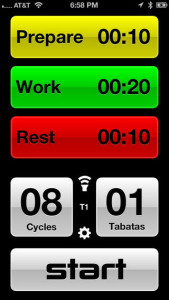 I feel a little late in coming to the dance. Folks have been talking about high intensity interval workouts for a long time. Yet, it’s only been recently that I have used the Tabata method. And I love it. For those who might also be a little late to the dance, the Tabata method was named for Dr. Izumu Tabata, a Japanese doctor and coach who discovered that short, high intensity exercise followed by shorter rest intervals showed the best performance in studies he conducted (the idea was originally pioneered by the head coach for the Japanese Olympic speed skating team, Irisawa Koichi and Tabata piggybacked on his research and knowledge).
I feel a little late in coming to the dance. Folks have been talking about high intensity interval workouts for a long time. Yet, it’s only been recently that I have used the Tabata method. And I love it. For those who might also be a little late to the dance, the Tabata method was named for Dr. Izumu Tabata, a Japanese doctor and coach who discovered that short, high intensity exercise followed by shorter rest intervals showed the best performance in studies he conducted (the idea was originally pioneered by the head coach for the Japanese Olympic speed skating team, Irisawa Koichi and Tabata piggybacked on his research and knowledge).
The Tabata method paper was published in 1996 in the journal “Medicine and Science in Sports and Exercise.” entitled, “Effects of Moderate-Intensity Endurance and High-Intensity Intermittent Training on Anaerobic Capacity and VO2max.” These doctors discovered that interval training produces much better results than aerobic training. This included building as much muscular endurance as 45 minutes of normal cardio training.
In fact in the study the subjects increased their anaerobic capacity by over a quarter as well as a substantial increase in their aerobic fitness. Something to keep in mind was that the the subjects were fit athletes before they started the trial, so the improvements were remarkable. The Tabata athletes improved their VO2 max (the body’s ability to use oxygen more effectively), which translated into improved performance on the ice (most were speed skaters). The other interesting finding was the the Tabata Protocol also improved the anaerobic energy system (the system responsible for short, high intensity exercise, such as sprints)
The High Intensity work phase for the Tabata protocol was originally performed at approximately 170% of VO2 Max. The VO2 max is a measure of the maximum capacity of your body to transport and use oxygen during a period of exertion or work. In simple terms this is an extreme intensity workout where you are working at close to your maximum heart rate. According to Dr. Tabata, the session should be only FOUR MINUTES LONG. It should consist of 8 sets of 20 second work sessions and 10 second rest sessions:
- Push hard for 20 seconds
- Rest for 10 seconds.
- Repeat this eight times.
Tabata exercise can be done with sprints, or with You can use exercises such as the front squat or push press if you are in the gym. Kettle bells work exceptionally well. Basically anything that you can put a large load on your biggest muscle groups. Be sure to use your large muscle groups otherwise you will get very little of the benefit.
If you do the workout correctly, you will not feel great. It is meant to be intense. The following are some of the things that you might notice/feel doing a Tabata workout:
- You should find it difficult to talk and breathe as you have oxygen debt.
- Significantly increased sweating.
- Elevated body temperature
- Increased lactic acid and the “muscle burning” sensation
Although this type of workout flies in the face of some of the traditional methods of aerobic exercise which focuses on longer, endurance type workout sessions, the results have shown that it is actually more effective. It is also extremely time efficient, which is why I like it so much.
Have you tried Tabata interval training?





Speak Your Mind